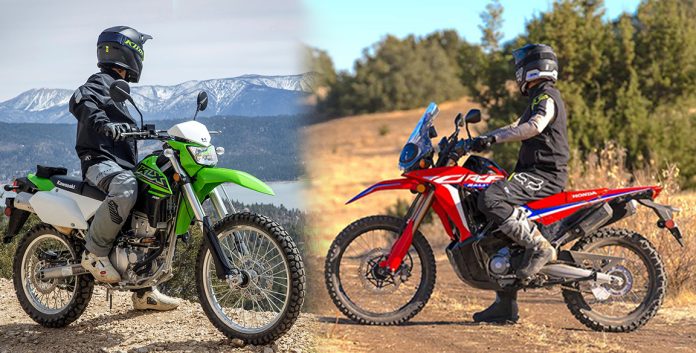Today’s article concerns the comparison review of the 2021 Kawasaki KLX300 vs 2021 Honda CRF300L. There is a greater variety of motorcycles than ever in the dual sport market. It is made possible by ultra-high-performance street-legal dirt bikes, such as Honda CRF300L and Kawasaki KLX300, that we’re evaluating here.
The KLX300 weighs 302 pounds and costs $5,599, while the CRF300L weighs 309 pounds and has an MSRP of $5,249. The Honda and Kawasaki belong to a distinct subsection of the dual sport segment: small-displacement commuter/play bikes, but they cannot be modified to be as dirt-capable.
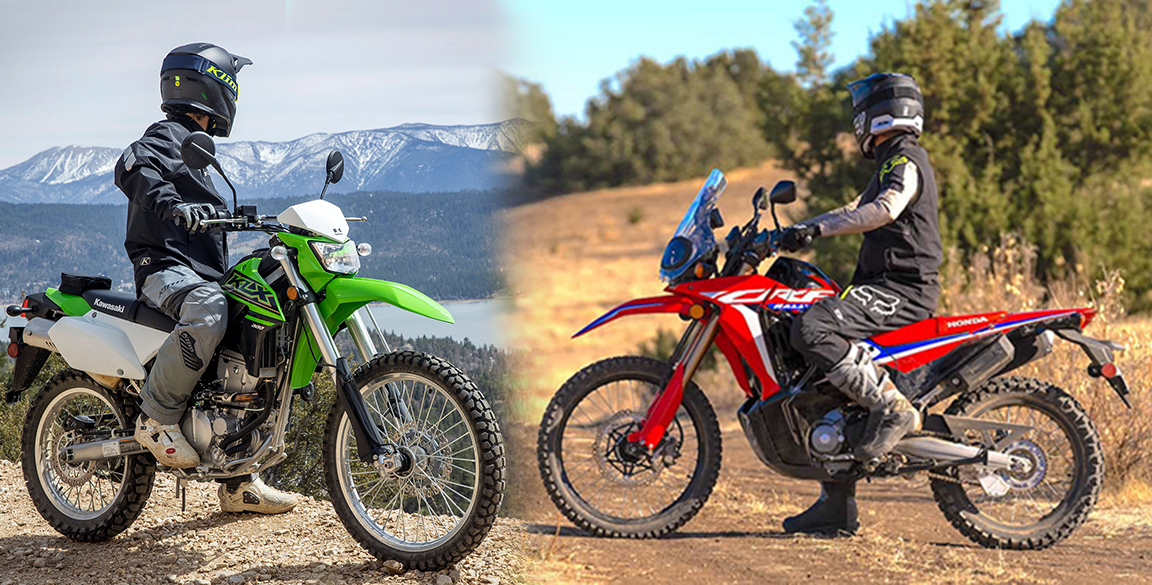
2021 Kawasaki KLX300 vs 2021 Honda CRF300L – Features Comparison
Why Small-Displacement Dual Sport Motorcycles Are Great
For 2021, updates to the CRF300L and KLX300 are made, with the engine displacement being the most significant modification. Each manufacturer has a different strategy for increasing engine size; Kawasaki gave its previous KLX250 a 6mm-larger bore, while Honda raised the stroke of its outgoing CRF250L by 8mm. Hence, the model name modifications and the 286cc and 292cc displacements rounded to the closest hundred.
Also Read: 2023 Honda Shadow Sabre 1100 vs 2023 Honda VTX1300
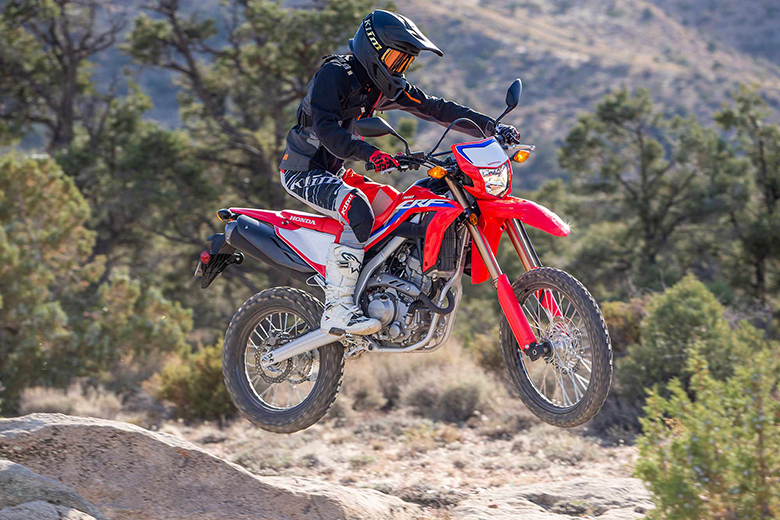
They are inexpensive to buy and maintain, have low seat heights, are simple to ride, are great for commuting, and consume little fuel. Although they may not be your first choice for challenging single-track trails, they are competent. They would be a much more appealing alternative for usage as a daily rider or even as a motorway traveler. Add a couple of extra pounds to the tires, fill the tank, and travel.
Dashboard
Tachometers, odometers, two trip meters, and clocks are included on both motorcycles. The CRF300L has an accurate fuel gauge and a gear position indicator, but the KLX300 has LEDs that turn on when the bike is in neutral and has low gasoline. Additionally, the Honda’s dash panel is taller, enabling more oversized gauge-face numerals that testers found easier to read.
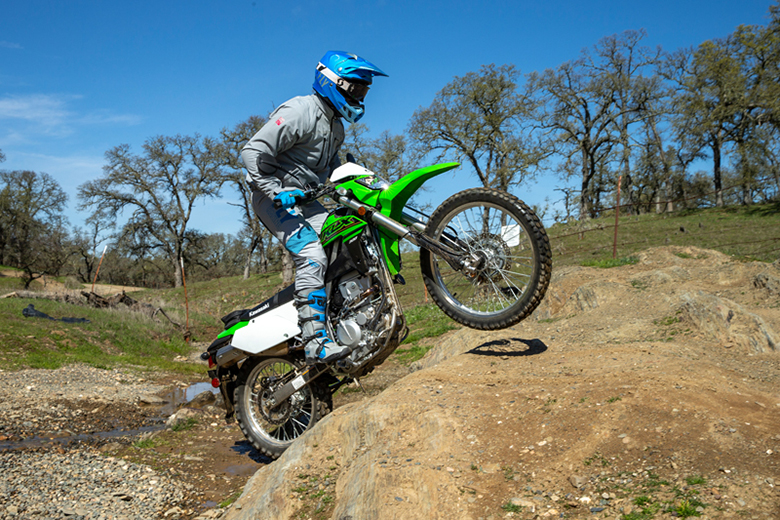
The Kawasaki’s suspension feels as cushy through the beginning portion of its stroke and also significantly firmer overall, making it tougher to keep a straight line. The Honda’s suspension, on the other hand, excelled, comfortably absorbing the rocky low-speed terrain.
Also Read: 2023 Indian Chieftain Dark Horse vs 2023 Harley Davidson Street Glide
Handling and Ergonomics
The Kawasaki can change direction with footpeg pressure more quickly thanks to its narrower and smaller overall feel. Speaking of stress, the footpeg platforms on the green machine are undoubtedly more minor than those on the Honda and focus more significant pressure on the rider’s feet; it seems like standing on a piece of rebar. In terms of handling, the Honda and Kawasaki were comparable.
However, its extra 7 pounds and broader cockpit, which includes the seat, midsection, and radiator shrouds, make it slightly slower to handle. Despite not being as sleek as the Kawasaki, reviewers gave Big Red high marks for its ergonomics.
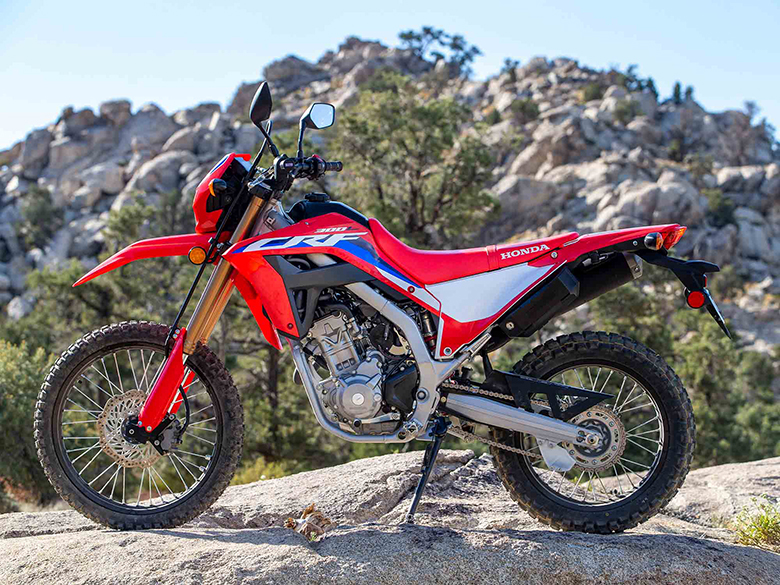
Suspension at High Speeds
A controlled, high-performance feel is provided by the Kawasaki’s KYB 43mm inverted fork and KYB shock. Giving it an astounding amount of what we sometimes call “holdup,” which helps it stay stable at speed. The suspension has excellent bottoming resistance and the capacity to absorb repeated bumps without packing down in the stroke, where the suspension would otherwise become too compressed to respond effectively.
Think of it as the ideal combination of stiff enough spring rates with good compression and rebound damping. Test riders could push the Kawasaki further and harder without the bike becoming crowded or unpredictable because of “holdup.”
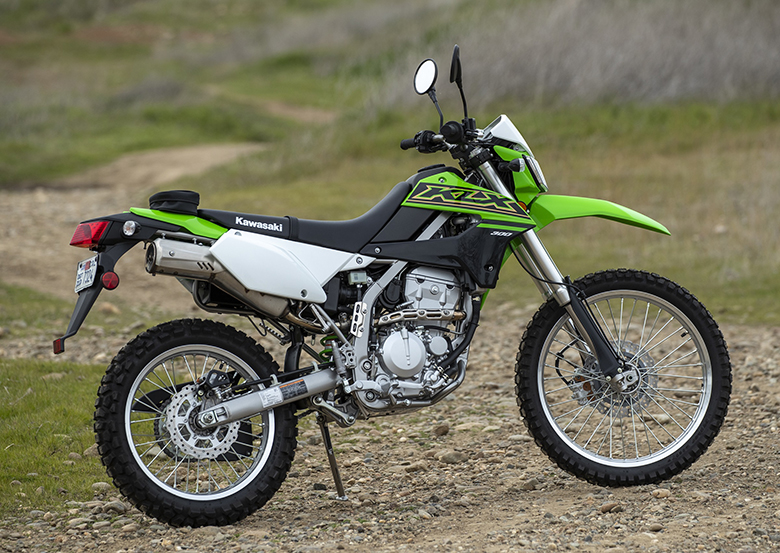
The faster-moving terrain also exposed the Honda’s most obvious flaw: an excessively supple general suspension setup. It was especially noticeable in the shock, which caused the back of the bike to ride low, occasionally blowing through the stroke and even bottoming out on more substantial impacts like G-outs. Riders were then propelled forward by an unsettling rebound effect as a result.
The Honda’s 43mm Showa inverted fork and Showa shock have no damping adjustments, so testers found themselves backing off and slowing down when faced with rugged high-speed terrain.
Brakes
The front brake on the Kawasaki has a nice progressive bite and better feel. It also has higher stopping power. Although the Honda’s front brake functioned satisfactorily, the lever was stiff and had little progressiveness. The two rear brakes were roughly equivalent.
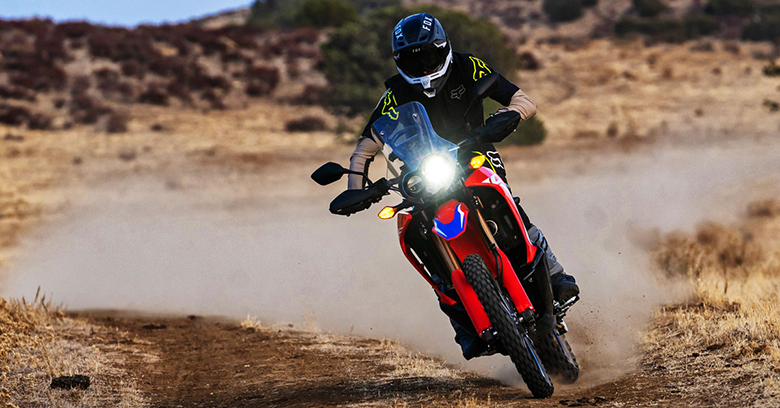
Gearbox and Clutch
Although the Honda’s clutch pull is undoubtedly the most superficial cable-actuated pull of any full-size off-road motorbike, the Kawasaki’s appears to be difficult when compared to it. That’s especially impressive considering the hydraulic clutch on a trials bike, created to be used continuously without tiring the rider’s hand.
In challenging terrain, the Honda continued to stand out. Its first-to-second gear separation was substantially narrower than the Kawasaki’s, making it more straightforward to ride in second gear through the narrower passages where the KLX300 performed best in first. On the green machine, the second gear could be used in these circumstances, but only if the clutch was constantly depressed and by a busy finger.
Additionally, the Honda’s lower second gear makes it simpler to accelerate from a stop. On the Kawasaki, greater clutch slipping is involved in the same scenario. On any bike, the third through sixth gears could be spaced similarly.
2021 Kawasaki KLX300 vs 2021 Honda CRF300L – Which Bike Should You Buy?
In factory trim, the Honda is a better fire-road ripper and commuting vehicle. It would be the clear winner if its suspension were modified by 15% to handle rougher off-road conditions. It costs $350 less, so you could use that money to have the Showa parts resprung or re-valved at the suspension shop.
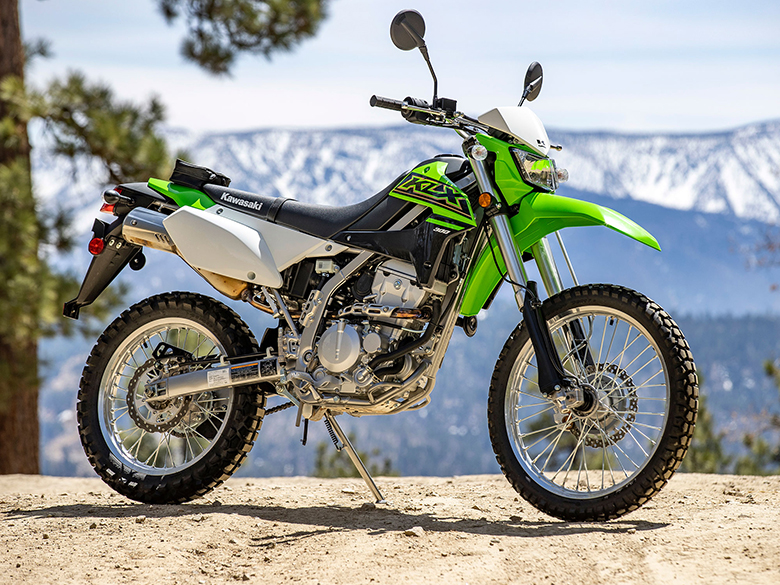
The Kawasaki’s most significant flaws are a notchy gearbox, a wide gap between first and second gear, and a more challenging clutch pull. However, its primary drawbacks are that it feels like an older motorcycle and is less polished than the CRF300L. Despite this, the KLX300 is the more capable bike right out of the box for a rider whose off-road ambitions go beyond accessible fire roads and mild two-track.
2021 Kawasaki KLX300 vs 2021 Honda CRF300L – Specification Comparison
| Specs \ Bikes | 2021 Kawasaki KLX300 | 2021 Honda CRF300L |
|---|
Price
| MSRP: | $5,599 (Lime Green)/$5,799 (Fragment Camo Gray) | $5,249/$5,549 (ABS model) |
Engine
| Engine: | DOHC, liquid-cooled single-cylinder; 4 valves | DOHC, liquid-cooled single-cylinder; 4 valves |
| Displacement: | 292cc | 286cc |
| Bore x Stroke: | 78.0 x 61.2mm | 76.0 x 63.0mm |
| Compression Ratio: | 11.1:1 | 10.7:1 |
| Transmission/Final Drive: | 6-speed/chain | 6-speed/chain |
Drivetrain
| Fuel System: | EFI w/ 34mm throttle body | EFI w/ 38mm throttle body |
| Clutch: | Wet, multi-plate; cable actuation | Wet, multi-plate slipper/assist; cable actuation |
Chassis
| Frame: | Steel perimeter | Steel semi-double-cradle |
| Front Suspension: | KYB 43mm inverted fork, compression damping adjustable; 10.0 in. travel | Showa 43mm inverted fork, nonadjustable; 10.2 in. travel |
| Rear Suspension: | KYB Uni-Trak shock, spring preload, compression damping, and rebound damping adjustable; 9.1 in. travel | Showa shock, spring preload adjustable; 10.2 in. travel |
| Front Brake: | Nissin 2-piston caliper, 250mm disc | Nissin 2-piston caliper, 256mm disc |
| Rear Brake: | Nissin 1-piston caliper, 240mm disc | Nissin 1-piston caliper, 220mm disc |
| Tires, Front/Rear: | Dunlop D605; 21 x 3.0 in. / 18 x 4.6 in. | IRC Foot Loose Trails GP-21F and GP-22R; 80/100-21 / 120/80-18 |
Dimension
| Rake/Trail: | 26.7°/4.2 in. | 27.5°/4.3 in. |
| Wheelbase: | 56.7 in. | 57.2 in. |
| Ground Clearance: | 10.8 in. | 11.2 in. |
| Fuel Capacity: | 2.0 gal. | 2.1 gals. |

